Spotted Salamander
Eastern U.S., from Maine south to southeastern Georgia; absent in Florida
A 10 to 20-gallon terrarium can house up to four adults. Start with a tank that can hold water and with a secure screen top, and lay down a 4-inch layer of ground coconut coir. Add treated or bottled spring water to the substrate, enough to make the dirt wet and the surface area damp. A few puddles of standing water won’t hurt a bit.
Although spotted salamanders absorb water through their skin and cloaca rather than drink, I provide a water bowl containing either treated or spring water, changing it daily. The water bowl doesn’t need to be huge, but it would be nice if it was large enough to hold all the tank inhabitants.
As for decór, cork bark works well, as do flat rocks and other bark, which the salamanders will hide under. Live plants add a nice touch, as do fake plants; use your own taste and talents (I am a plant killer, so it’s plastic or silk for me).
No heating is needed, as spotted salamanders do best at between 50 and 70 degrees Fahrenheit. Try to keep them cool and damp. There are no other secrets to keeping them alive; no lighting is needed, unless you desire it. If so, use a low-heat fluorescent bulb to keep down the heat.
Spotted salamanders will eat almost anything they can catch and swallow. Pets will take chopped night crawlers, red wigglers, crickets, and small roaches. Large salamanders will take live pinky mice. If it’s live and moving, they will try to tackle it. Spotted salamanders will even eat smaller versions of themselves, so try to keep tankmates about the same size.
Spotted salamanders are almost always field collected. Captive breeding is rare, so if you do find them for sale you can pretty much assume they are wild caught, unless you are told otherwise. I have seen albinos in the past, but these are very rare in the hobby, so getting your hands on some is pretty unlikely. That’s okay, though, as the normal-colored ones are beautiful.
Spotted salamanders are somewhat seasonal, more commonly seen in the cooler winter months. Your best bet to locate them is at specialty reptile stores.
When threatened, spotted salamanders secrete a mild sticky toxin from the back and tail that dissuades predators such as skunks, raccoons, turtles, chipmunks, squirrels, opossums, and snakes from eating them.
Spotted salamanders are very personable and make great pets. Make sure you wash your hands before and after you handle them, and they will live for a couple decades. They’re easy to care for and inexpensive to maintain.
Get some!
Ken Foose produced his first captive-bred snakes at age 11. With a Master’s Degree in zoology, he has been both a zookeeper and curator. He opened Exotic Pets, which specializes in reptiles and amphibians, in Las Vegas in 1991. He is currently president of the International Herpetological Symposium.

